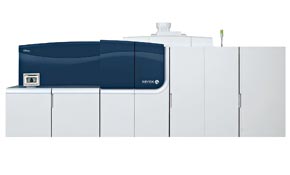
What does the machine do?
The CiPress 500 is, according to Xerox, the world’s first high-volume waterless inkjet printer. The manufacturer says the specially developed solid inks are designed to produce more vibrant and consistent colours even when printing on offset papers. This, says Xerox, enables customers to save money by using less expensive stocks while cutting costs on postage and paper inventory as well.
“The postage and workflow are all important parts of a complete solution,” says Simon Lane, national manager of graphic communications at Fuji Xerox Australia.
“If you can start using lighter weight papers then you can get more sheets in an envelope for the same postage. You also have to consider how much manpower is needed to manage the inventory of paper. Some printers have warehouses full of paper with a number of staff managing the inventory. If you reduce inventory and bring it down to a fewer number of papers that’s going to be less of a cost.”
When did it launch and who is it aimed at?
The CiPress was launched earlier this year with an installation at DMH Marketing in the US. Lane says: “Fuji Xerox Australia has already had a number of engagements with our local clients for this new platform, which we anticipate will become available in Australia in 2012.”
The press is targeted at a variety of markets including transactional and transpromo mail, as well as magazine and catalogue publishers. Xerox says the device can deal with a high throughput of data and complex images. The vendor anticipates that magazine and brochure printers will be attracted by the CiPress 500’s ability to produce colour-rich documents without reducing speed.
Lane thinks other applications will also emerge: “Ultimately, whenever any vendor brings a new press to market what happens is the customers actually show them where all the applications really are. I suspect it’ll be no different here.”
How does it work?
Xerox says the CiPress is capable of producing vibrant colours thanks to its waterless inks. These sit on the surface of the paper, like toner, rather than soaking in. The inks start life as a solid and are heated into a liquid by the press, turning back into a solid when they hit the page. Xerox says not only does this produce stronger colours, it can also reduce energy costs as no energy-intensive drying system is needed. The vendor adds that this also reduces the risk of cockle and curl in output, as well as how frequently print heads become clogged, as waterless inks are less affected by evaporation.
Does it have other USPs?
The CiPress borrows technology from other Xerox machines, notably the ‘scanbar’ from its iGen4, which detects failed or blocked print heads and signals to the other nozzles to apply more ink to compensate. When too many heads are down, the bar alerts the operator that maintenance needs to be carried out.
Lane says: “A robot inside the machine will clean the heads so the operator doesn’t have to. There are different versions of self-cleaning out there, but ours is good because it can be done while a roll of paper is being loaded.” The amount of ink wasted in cleaning is also less than in aqueous systems, according to Xerox.
What training is available?
Operator training typically takes between one and two weeks. The aim, says Lane, is for the operator to be able to deal with certain service events themselves. “The reality is that in most cases the operator’s right there in front of the machine and probably knows how to fix it in a few minutes, so why not give them the appropriate skills training so that they can do these things?”
Specs
Speed 152m/min
Resolution 600x400dpi
Substrates Pin-fed, pinless, uncoated, offset, recycled, bond, newsprint
Stock weight 50–160gsm
Price US$3.8m ($3.7m)
Contact Xerox (02) 9856 5000 www.fujixerox.com.au
The Alternatives
Océ JetStream Dual series
The series is comprised of the JetStream 1500, 2200 and 3000, which run at 100, 150 and 200m/min respectively. They incorporate DigiDot inkjet technology with a smallest settable droplet sizes of 7-12 picoliters. The kit features a multilevel option, which Océ says leads to a perceived image quality of 1,200dpi without reducing speed.
Speed up to 200m/min
Resolution 1,200dpi (perceived)
Substrates newspaper, recycled, laser, inkjet treaded and inkjet coated
Stock weight 64–157gsm
Price from $2.8m
Contact
Océ 1300 663 623
www.oce.com.au
InfoPrint 5000 GP
The 5000 GP platform is designed for applications with colour, mono and MICR capabilities. It uses drop-on-demand inkjet and complements the InfoPrint 5000 MP and VP platforms by providing a modular design and flexible configurations.
Speed up to 128m/min
Resolution 720dpi
Substrates inkjet, ground wood, recycled, offset and an increasing number of coated stocks
Stock weight 64-130gsm
Price $800,000 to $2.5m depending on configuration
Contact
Ricoh
1800 181 002
www.ricoh.com.au
Comment below to have your say on this story.
If you have a news story or tip-off, get in touch at editorial@sprinter.com.au.
Sign up to the Sprinter newsletter
